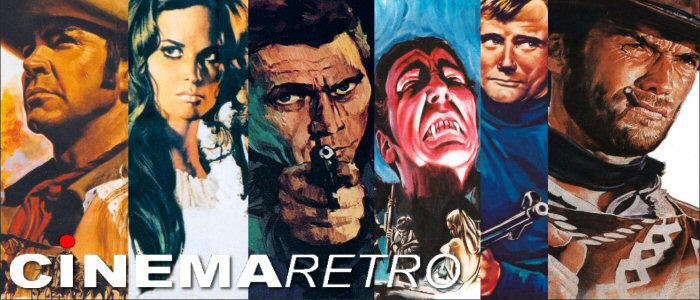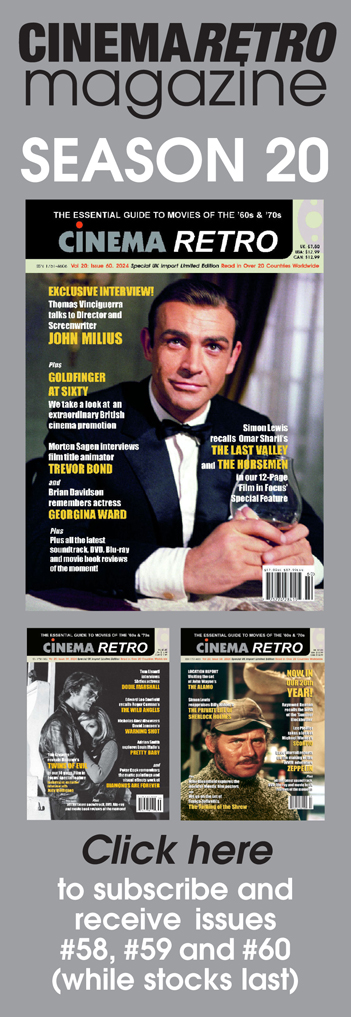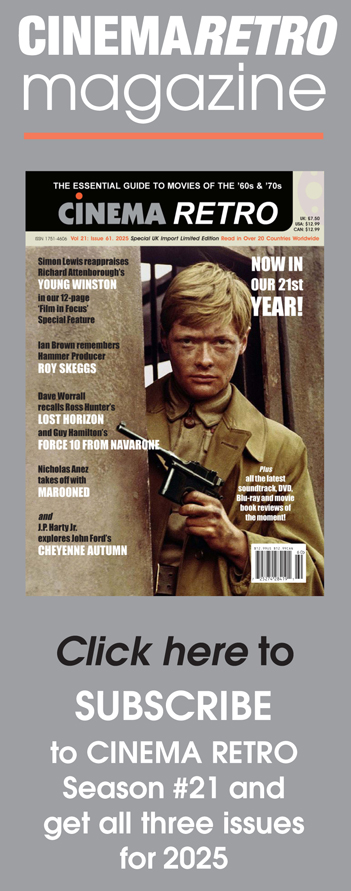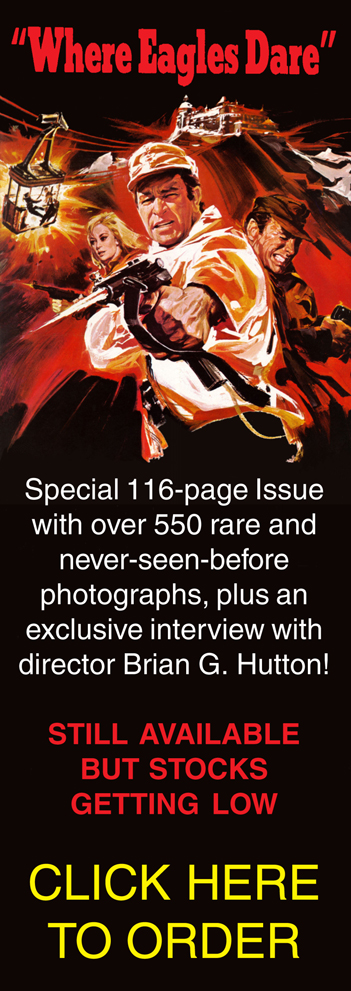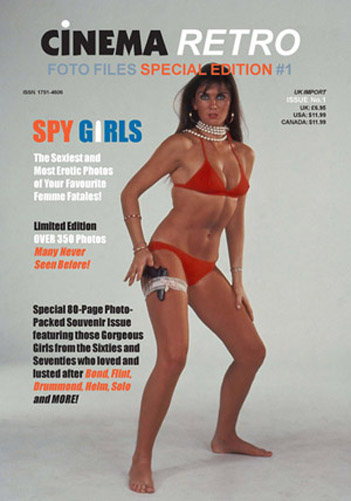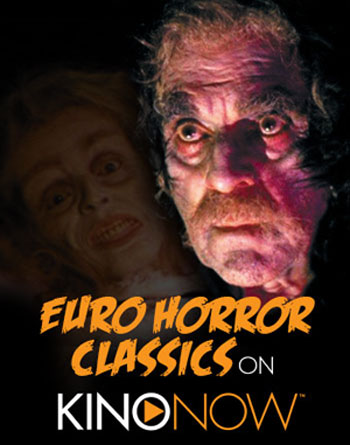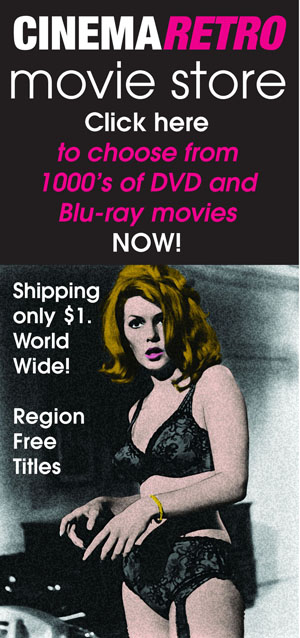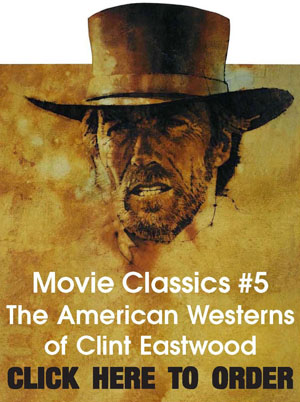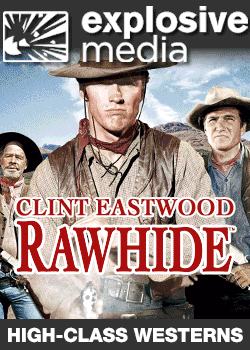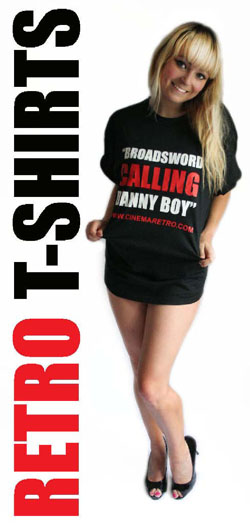
EVE GOLDBERG presents an in-depth examination of the only film Marlon Brando ever directed: "One-Eyed Jacks" (1961)
"ONE-EYED JACKS: AMERICA AT THE CROSSROADS"
A new movie schedule arrived
every few months. A two-sided paper
treasure chest brimming over with promises of time travel, existential wisdom,
and singing in the rain. Wild
Strawberries, City Lights, Battle of Algiers, Belle de Jour.
We grabbed up the schedule
and studied it with care, taped it to the refrigerator door, marked our
calendars. The African Queen, Yojimbo,
Rules of the Game.
We made cinema voyages all
over town — to the Vista in Hollywood, the Nuart in West LA, the art deco Fox
Venice. Before VCRs, DVDs or streaming,
revival movie theaters were about the only place a film junkie could get a
fix. We might find an occasional nugget
on late night TV, John Ford’s Stagecoach,
perhaps, or Invasion of the Body
Snatchers, but for the most part, it was the revival house or nowhere. Citizen
Kane, La Dolce Vita, Alphaville.
There was rumor of a weird
Western called One-Eyed Jacks,
starring and directed by Marlon Brando. Nobody we knew had seen it. The
movie took on the aura of myth. Was there really a scene where Brando gets
whipped? What had the famously
iconoclastic actor done with the time-worn clichés of the horse opera?
Finally, I think it was
1974, One-Eyed Jacks arrived. We trooped down to the Fox Venice, waited in
a long line, found seats in the filled-to-capacity theatre, and settled in for
the ride. We were not disappointed. From the opening shot — Brando casually
eating a banana during a bank robbery — the film was like no Western we had
ever seen. Moody, psychological,
ambiguous, it was awash in sadomasochism, with a brooding Brando in nearly
every scene. And yes, the actor gets his
whipping in a scene of perverse cruelty which sears into memory.
Back in 1974, we knew we had
seen an odd, strangely subversive, one-of-a-kind film. We didn’t know, however, that this quirky
little revenge gem would someday be considered an important (if flawed)
masterpiece of cinema, and a fascinating link between two eras in Hollywood…and
America.
The Western is a
quintessentially American film genre. From its earliest days, the cowboy drama was about good guys (white
lawmen) confronting bad (Indians, outlaws). Each movie was a tale of expansionist dreams and masculine
aggression. Each was a saga of
civilization triumphing over savagery. The Western was, to quote film critic J. Hoberman, “the way America used
to explain itself to itself.â€
Edwin Porter’s 1903 film, The Great Train Robbery, was one of the
first Westerns. This 12-minute story in
which bandits rob a train, only to be pursued by a posse of lawmen,
revolutionized the art of cinema. Porter
used ground-breaking techniques such as cross-cutting and close-ups to create a
suspenseful, compelling narrative. The
basic elements of the genre were set.
The Western remains
instantly recognizable across more than a century of evolving media and
myth-making. Gunfights, holdups, and
massacres. Horses, trains, rustlers, and
barroom brawls. School-teachers,
stampedes, and six-shooters.
The Golden Age of the
Western is often considered to be the years 1946-1973. Following World War II, with the Cold War
blazing hot on the beaches of Korea, the U.S. declared itself the new global
sheriff in town. At home, the Eisenhower
Era earned a reputation as being a time of complacency and consumerism. But these were also the McCarthy years, when
right-wing witch hunts against political progressives were ruining lives and
careers. And, at the same time, the seeds
of change were taking root. A young
civil rights movement began asking America: What the hell are the good guys who
fought Hitler doing about racial discrimination and bigotry at home?

In this landscape, mature
conventional Westerns like My Darling
Clementine (1946), Shane (1953),
and Rio Bravo (1959) stood shoulder
to shoulder with a new type of movie. Westerns such as Broken Arrow (1950), High Noon (1952), and Johnny
Guitar (1954) tweaked, twisted, and updated the genre — Broken Arrow with a sympathetic
portrayal of Native Americans; Johnny
Guitar with an arch Joan Crawford at the center of a sexually ambiguous
melodrama; High Noon as a parable of
the anti-communist witch hunts which were plaguing America (and Hollywood) at
that time.
Two landmark Supreme Court
decisions opened the way for these unorthodox films to be made. In 1948, the Court ordered the Hollywood
studios who owned theater chains —MGM, Paramount, 20th Century Fox,
Warner Brothers, and RKO — to divest themselves of those theaters. The idea was that a studio’s control over
production, distribution, and exhibition represented restraint of trade. In 1952, citing the First Amendment’s freedom
of speech clause, the Court eliminated government censorship from movies. Until that ruling, there had been hundreds of
state and local “decency†ordinances that the film industry felt compelled to
follow. Now, less fettered by censorship
(Hollywood still had to deal with pressure from conservative religious groups),
filmmakers were freer to produce unconventional fare. Untethered from studio demands, exhibitors
were free to book a wider range of movies.
The movie studios were also
facing stiff competition from the new medium of television. I Love Lucy, Gunsmoke, and Leave It To
Beaver were pulling eyeballs (and revenue) away from the cinema. Movies sought to differentiate themselves
from their small screen cousins. One way
was to GO BIG. Wide-screen, Technicolor,
3-D, stereo. Another was to go
off-beat. Influenced by the edgy,
innovative films coming out of Europe, a slice of American movies began to
shade darker, bleaker. They began to
challenge mainstream values.
And into this mix of
cultural and economic change stepped the brightest star in the Hollywood
galaxy.
Marlon Brando’s 1947 tour de
force performance as Stanley Kowalski in the Broadway production of Streetcar Named Desire revolutionized
the art of acting. His performance in
the film version of Streetcar made
him an international movie star and sex symbol. In The Wild One, Brando transformed himself into an alienated,
leather-jacketed biker — and became the poster boy of rebellious youth. In 1954, he won his first Oscar for his
portrayal of a deeply conflicted, tough-but-vulnerable, dockworker who rats out
a corrupt union boss in On the Waterfront.
By age 31, Marlon Brando was
the most popular movie star in the world. He was a bigger box office draw than Cary Grant, John Wayne or Jimmy
Stewart, all of whom were beginning the downside of their careers. His contemporaries, James Dean and Montgomery
Clift, were either dead (Dean, at age 24 in a car crash) or in steep decline
(Clift in a drug and alcohol haze).
But Brando wanted to do more
than act.
It was exactly at this time
that the Hollywood studios were losing their grip on the film industry. Without their own theaters, the studios were
no longer motivated to churn out copious amounts of product each week to fill
seats. Add to that, movies were losing
audience share to television. So the
studios began cutting back on the number of films they released each year. With less product in the pipeline, they were
choosing not to renew hefty, long-term contracts with their top players. Movie stars including Burt Lancaster, Cary
Grant, and Kirk Douglass used this opening to form their own production companies.
Brando named his company
Pennebaker Inc. in honor of his late mother (Pennebaker was her maiden
name). He said that the purpose of his
new venture was, “to make pictures that were not only entertaining but had
social value and gave me a sense that I was helping to improve the condition of
the world.â€
The big studios still
provided the sound stages, technicians, know-how, and big bucks for smaller
companies. Pennebaker partnered with
Paramount, setting up shop on their Melrose Avenue lot. Pennebaker’s first film was Sayonara, the story of an American ace
fighter pilot (Brando) who falls in love with a Japanese actress. The movie dealt with issues of racism and
bigotry. It was a critical success.
Brando was particularly
interested in making a Western. For
several years, he looked for properties to adapt, and worked on developing a
script set in the Old West. At one
point, he even attempted to adapt The
Count of Monte Cristo to the Old West. But nothing seemed to jell. Then he caught wind of a novel, The Authentic Death of Hendry Jones,
based loosely on the Pat Garrett/Billy the Kid legend. The book had already been optioned by
producer Frank Rosenberg, and a screen adaptation written by Rod “Twilight Zone†Serling. Serling’s script was being revised by a bit
actor with aspirations to write and direct — Sam Peckinpah. Brando brought the book, screenplay,
producer, and writer over to Pennebaker. He worked with Peckinpah on the script for a while. Eventually, he replaced Peckinpah with novelist/screenwriter
Calder Willingham, who in turn was replaced by veteran screenwriter Guy
Trosper.
To direct, Brando hired
maverick filmmaker Stanley Kubrick, fresh off his anti-war film Paths of Glory. However, after working together for six
months, Brando and Kubrick couldn’t agree on a final script. So they agreed to part ways. Brando decided to direct the movie himself.
For the cast of One-Eyed Jacks, Brando assembled a group
of supremely talented character actors, including Katy Jurado, Ben Johnson, and
Slim Pickens. He chose his close friend
and fellow Method actor, Karl Malden, to co-star. Shooting began in 1958, in Monterey,
California. Along with his acting and
directing duties, Brando worked daily with screenwriter Trosper, revising the script. “I was making it up as I went along…I didn’t
know what I was doing,†the first-time director readily admitted.
Interested in bringing
emotional and psychological depth to his Western, as well as a feeling of
spontaneity, Brando encouraged his cast to improvise their lines. Numerous takes were shot, each a bit
different, until the director got what he was looking for. Conscious of his directorial inexperience,
Brando also made sure to cover each scene from numerous angles, shooting more
than most directors would, to be sure he had what he needed for editing.
Understandably, Brando cared
deeply about this movie; he wanted everything to be just right. On location in Monterey, with a large cast
and crew on payroll, he waited for just the right light, just the right wave,
before shooting a scene. All this took
time. Shooting ran over-schedule. The budget began to balloon. Paramount executives, who were funding the
film, began to get nervous.
Next, filming moved onto the
Paramount lot, where elaborate sets such as the “fiesta scene†had been
built. In the controlled environment of
a Hollywood studio, things were expected to go more smoothly. But no such luck. In a freak Los Angeles storm, the One-Eyed Jack sets were destroyed.
Final filming took place in
Death Valley, California, where temperatures hit 117°. In addition to this extreme heat, the
production team had to deal with their lead actor’s obvious weight gain. Brando had steadily put on pounds during the
course of production. His costumes
needed to be adjusted and re-sewn — again and again. Camera angles were arranged to mask his
expanding girth.
By the time shooting was
complete, One-Eyed Jacks’s three
month shooting schedule had stretched to six.
After months of painstaking
editing, Brando finally screened his cut for Paramount. The movie was eight hours long. Paramount insisted that he drastically
shorten the film. They also demanded
re-shoots, including a new “happier†ending. Brando and his editor began re-cutting. The production team was re-assembled and the requisite new scenes were
shot. When Brando showed the studio his condensed
cut, it was five and a half hours long. At this point, Paramount took over the editing process. Brando walked away from his movie in frustration
and disgust. He would never approve the
final cut.
By the time it was complete, One-Eyed Jacks’s $1.8 million dollar
budget had swollen to $6 million. Today,
many would agree that the 141 minutes that made it to the screen was worth
every penny.
Shot in sumptuous,
wide-screen VistaVision, with elaborate set pieces and studio-created costumes,
One-Eyed Jacks has the look and feel
of an old fashioned Hollywood Western. Plot-wise, it is a classic revenge story. The movie begins with Rio (Brando) and his
partner, “Dad†Longworth, robbing a bank in Mexico. Longworth betrays Rio and takes off with the
loot, leaving Rio to rot in a Mexican prison for five years. After he escapes, Rio tracks down Longworth
who is now a prosperous sheriff in a small California town, He finds Longworth ensconced in a comfortable
home with a Mexican-American wife and a grown step-daughter, Luisa. Thirsting for revenge, Rio plots with new
outlaw partners to rob the town bank right under Longworth’s nose. For further revenge, he seduces the sweet and
innocent Luisa.
Longworth seethes when he
discovers that his former friend has seduced his step-daughter. He captures Rio and personally administers a
vicious public whipping. Then he crushes
Rio’s gun hand. Rio and his gang retreat
to a nearby fishing village where Rio recuperates and plans his next move. Without Rio’s approval, the gang robs the
bank. The robbery turns into a shoot-out
and a girl is accidentally killed. Using
the killing as a pretext (even though Rio was not even present for the
incident), Longworth puts Rio in jail to await his execution by hanging. Luisa,
who has fallen in love with Rio, tries to help him escape, but fails. Eventually, Rio escapes on his own. He kills Longworth in a shoot-out and rides
off with Luisa.
However, within this typical
Western plot, lies a subversive story. From the opening scene where bank robber Rio eats a banana, then
casually tosses the peel onto a gold scale, the film is in rebellion against
the conventions of the genre. For
starters, while early scenes take place in the arid Mexican desert, much of the
later action is set against the crashing surf of the verdant Monterey coast,
assuring that the movie never quite feels like a “normal†Western.
Released in 1961, here’s
what major critics had to say about the movie at that time.
“It proceeds in two
contrasting styles,†wrote New York Times
critic Bosley Crowther. “One is hard
and realistic; the other is romantic and lush. All he way through it runs a jangle of artistic ambivalence.â€
“The bizarre action is set
off by the classic Hollywood iconography of the western landscape,†opined Dave
Kehr in the Chicago Reader.
Perhaps, though, it’s less
the actual action which is bizarre, but rather the meaning woven into the action, the psychological and emotional
reverberations that ricochet around each scene, seemingly incongruous amongst
the Old West tropes of gunslingers, outlaws, sagebrush, and horses. Add to that a layer of political subversion
that simmers just below the surface, and it’s no wonder that critics and
audiences didn’t quite know what to make of this strange cinematic stew.
The Original Sin of America
is the enslavement of Africans and the genocide of the Native population. Slavery and slaughter were the bedrock of the
new nation’s wealth. One-Eyed Jacks works as a subtle
indictment of white supremacy, patriarchy, and imperial conquest, striking at
the core of the American project. Whether this was a deliberate ideological choice, or whether more the
expression of an incipient sensibility — or some of both — we’ll never know.
What we do know is what we
see. And what we see is a revenge plot
which serves as the scaffolding for a complex questioning of values. The Original Sin of One-Eyed Jacks is Dad Longworth’s betrayal of Rio in the mountains
of Mexico. Longworth uses the gold he
pockets during this betrayal to begin his climb to prosperity and power in
California. As sheriff of Monterey, he
rules as a benevolent, blue-eyed, patriarch. At the annual town fiesta, he speaks from a high platform to his people
— a happily diverse crowd of whites and Mexican-Americans. Beside Longworth floats an oversized balloon
painted with the words Fair Play For All. At home with his Mexican wife and
step-daughter, Longworth plays the role of devoted, loving, husband and
father.
Then Rio shows up and
threatens to crack open the whole façade.
While the town folks of
Monterey are aware of Longworth’s outlaw past, they don’t know about his morally
corrupt soul. “You may be a one-eyed
jack around here, but I’ve seen the other side of your face,†Rio says to his
antagonist.
But in truth, there are two
one-eyed jacks in town. Rio, like
Longworth, uses deception to get what he wants. In particular, he exploits and deceives women. At the beginning of the film, he steals a
ring from a woman during the bank robbery, then gives it to the Mexican
senorita he is seducing. “My mother gave
this to me right before she died,†he lies. Later, he uses this same ploy with Luisa, presenting her with a necklace
he just bought off a street vendor and passing it off as his mother’s. “It would be an honor if you’d wear this,†he
oozes with fake sincerity.
Longworth and Rio’s deceits
create parallel emotional blowback. Neither man is at peace with his own behavior. Both turn their unacknowledged shame
outward. Longworth needs to punish and
kill Rio not simply to maintain his standing in the community, but to silence
his guilt for betraying Rio in Mexico. His self-image as a “good guy†demands that he kill all knowledge of his
wrongdoing. “You will do anything,†his
wife confronts him towards the end of the movie, “to hide the memory of what
you did to him,â€
Likewise, “good guys†don’t
hurt women. So, like Longworth, Rio
turns his guilt outward as well. In
denial that his lying and manipulation of women is hurtful and abusive, Rio
seems to draw the line at physical abuse. When he witnesses a man mistreating a women in a bar, he seethes and
eventually comes to her rescue. His
intervention sets off a shootout during which he kills the abuser.
One of the salient tropes of
the Western is the rationalization of violence. The hero is morally licensed to kill as long as his enemy is presented
as hideous enough to warrant annihilation. (Scalp-taking Indians, for example. Or bomb-wielding Arab terrorists.) As a Western hero, Rio is excused for his aggression towards unsavory
characters such as the woman-abusing bar patron or the lecherous deputy
sheriff. These antagonists are portrayed
as worse than Rio —perfect foils for the genre, perfect targets for Rio’s
projected shame.
But unlike the conventional
Western hero, Rio eventually looks inward. In the course of his relationship with Luisa, he grows emotionally. He gains self-knowledge. He realizes that his lies have consequences,
that his actions have hurt Luisa. He
admits to her that “everything I told you last night was lies.†Admitting to his deceit, he is free to
change. After much brooding and hesitation,
he decides to give up his revenge quest to seek a life of possible happiness
with Luisa. Which is where Rio and
Longworth’s psychological trajectories diverge. Longworth never budges from his need to kill his projected inner demons.

In another turn away from
tradition, the main women characters in One-Eyed
Jacks do not conform to the stereotypical Madonna/prostitute split. Both Luisa and her mother, Maria, are women
of “hearth and home.†They are also
sexual outlaws. Both have sex and become
pregnant out of wedlock. And neither is
ashamed of this fact. Maria lies to her
husband in order to protect her daughter’s affair with Rio. When the game is up, she finally tells her
husband the truth. His response — “Is
this the thanks I get for taking you out of the bean fields?†— reveals the
racist underpinnings of his domestic tyranny.
And speaking of racism, as
the movie progresses and lines are drawn, those who align themselves with Rio —
Luisa, Maria, and his loyal friend Modesto — are all people of color. The “bad guys†are all white males, each of
whom is revealed as a bigot of one sort or another. When Rio and his gang retreat to a small
Chinese fishing village so he can rehab his crushed hand, gang member Bob Emory
is cruel and dismissive towards the Chinese villagers. Later, while betraying Rio, Bob sneers that
Modesto is a “greaser†— just before gunning him down.
One-Eyed
Jacks was not the only anti-racist Western of its time. Films such as Devil’s Doorway (1950), The
Searchers (1956), and Two Rode
Together (1961) dealt with issues of racism. Likewise, Brando’s film was hardly the only
psychological Western of its era; the 1950s were a time when psychoanalysis was
big in Hollywood culture. Often noted
for its Oedipal intimations (“Dad†Longworth, anyone?), One-Eyed Jacks joins a crowd of other “Oedipal Westerns†such as Red River (1947), The Man From Laramie (1955), The
Last Sunset (1961).
However, with its vague
coalition of outsiders, its psychological depth, and its impulse to re-write history,
One-Eyed Jacks, astutely presaged the
future of race, gender and counterculture politics.
When the film was released
in 1961, critiques of patriarchal power and racist hegemony were not exactly on
the lips of the general public. To the
contrary, that was the year President Kennedy inaugurated his New
Frontier. Harnessing Old West symbolism
in the pursuit of global domination, the western frontier moved from Kansas to
Indochina. In the slang of war,
C-rations were dubbed John Wayne cookies, danger zones were referred to as
Indian Country, and secret military ops were codenamed Sam Houston and Daniel
Boone.
As the 1960s became The Sixties, a counter narrative
emerged. Young people protesting the war
in Vietnam allied with African Americans, Chicanos, Native Americans, women,
and gays fighting for civil rights. Counterculture youth grew long hair, wore beads and headbands, lived in
communal (tribal) houses. One
underground newspaper was named the
Berkeley Tribe.
One-Eyed
Jacks not only foreshadowed the new social consciousness of the
1960s, it also prefigured the counterculture-ish revisionist Westerns that
followed. Movies such as Little Big Man (1970), McCabe & Mrs. Miller (1971), and Blazing Saddles (1974) blatantly flipped
conventions of the genre as they skewered American expansionism, capitalism,
and white supremacy.
Perhaps, given the social
messages layered into One-Eyed Jacks,
it’s no surprise that Marlon Brando became a political activist in the
1960s. He was an early supporter of the
civil rights movement, participating in the 1963 March on Washington alongside
Dr. Martin Luther King. In 1964, he was
arrested while protesting a broken treaty that had promised fishing rights to
Native Americans in the Pacific Northwest. Later in the 1960s, Brando became a supporter of the Black
Panthers. Most famously, in 1973, he
declined the Academy Award for Best Actor in The Godfather. In his place,
he sent to the stage Native American actress Sacheen Littlefeather who read a speech
about the poor treatment of Native Americans in the film industry. Brando remained a supporter of activist
causes for the rest of his life.
The ending of One Eye Jacks is emblematic of its spot
in film history — one foot in old Hollywood, one foot in a new kind of
cinema. At the conclusion of the movie,
Rio shoots Longworth in a final gun fight. As scripted and originally filmed, Rio and Luisa begin their escape on
horseback, but a dying Longworth gets off one final shot, accidentally killing
Luisa. Paramount, however, demanded a
change. The ending was considered too
downbeat and depressing. New scenes were
shot, and the ending was re-edited. In
the final version, Longworth’s bullet hits nothing but dust. Luisa lives. She rides out of town with Rio, and they say a sappy goodbye at the
beach, Rio promising to return in time for the birth of their baby.
If that ending sounds
tacked-on and schmaltzy on paper, it plays even worse on screen. The viewer is left with a saccharine
sentiment incongruous with the bulk of the film. On the other hand, for a movie whose outstanding
feature may be its artistic ambivalence, the ending is just about right.
(Eve Goldberg is a writer and filmmaker. Her
articles have appeared in Hippocampus, The Gay & Lesbian Review, The
Reading Room and AmericanPopularCulture.com. Her film and television
credits include Emmy-nominated Legacy of the Hollywood Blacklist, and Cover Up:
Behind the Iran-Contra Affair. Her first book, Hollywood Hang Ten, is a
mystery novel set in 1963 Los Angeles. See a sampling of her short films on her web site at https://eve-goldberg.com/
CLICK HERE TO ORDER CRITERION BLU-RAY SPECIAL EDITION FROM AMAZON
